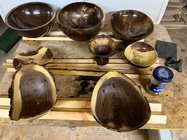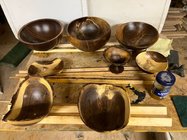- Joined
- Apr 27, 2004
- Messages
- 8,652
- Likes
- 5,014
- Location
- Lakeland, Florida
- Website
- www.hockenberywoodturning.com
What are the 'cons' of finishing on the lathe?
I like to finish several pieces at the same time. A lot easier, quicker, and better quality when I finish 3-5 pieces together.
1 set up, 1 clean up. If I’m buffing they all go through the Tripoli, white diamond, carnuba.
I do all the signatures at the same time too.
Also really hard for me not to leave streaks when finishing on the lathe.


